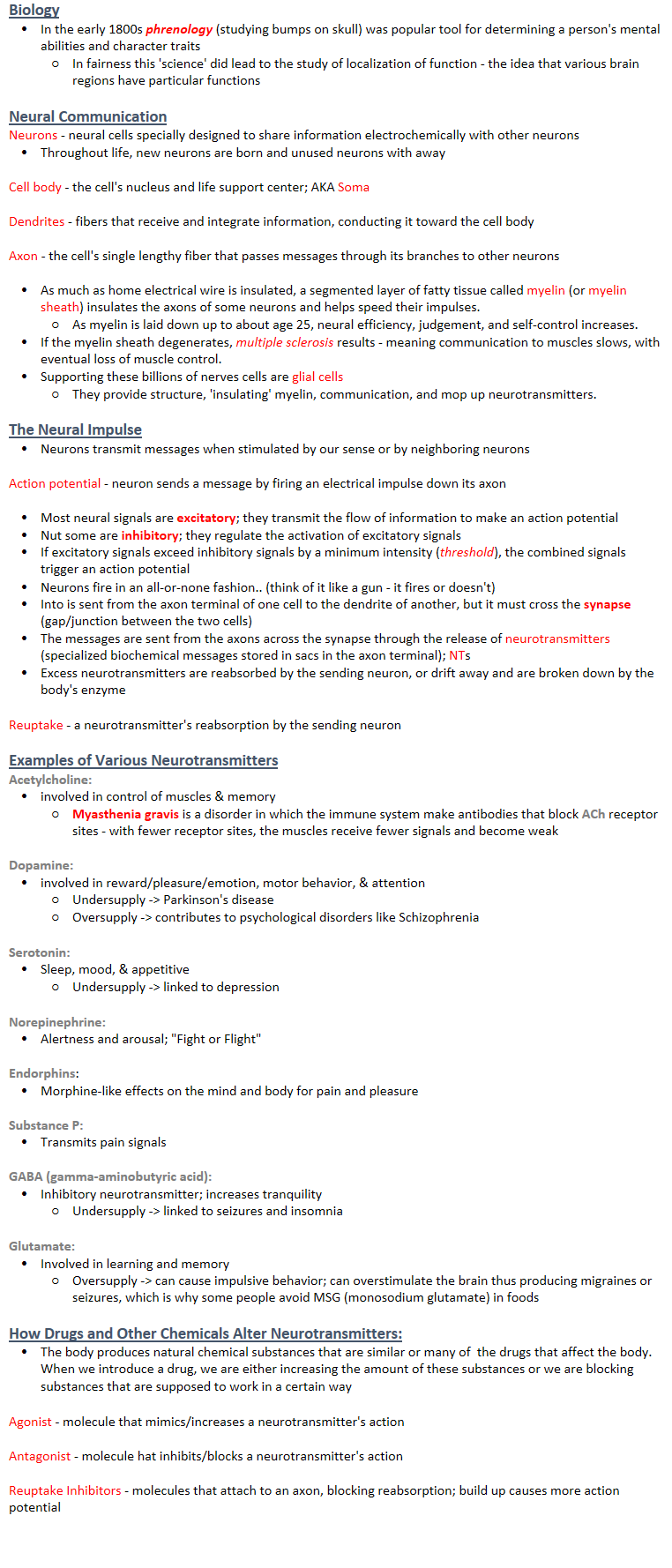AP Psychology - 1.7
Biology
In the early 1800s phrenology (studying bumps on skull) was popular tool for determining a person's mental abilities and character traits
In fairness this 'science' did lead to the study of localization of function - the idea that various brain regions have particular functions
Neural Communication
Neurons - neural cells specially designed to share information electrochemically with other neurons
Throughout life, new neurons are born and unused neurons with away
Cell body - the cell's nucleus and life support center; AKA Soma
Dendrites - fibers that receive and integrate information, conducting it toward the cell body
Axon - the cell's single lengthy fiber that passes messages through its branches to other neurons
As much as home electrical wire is insulated, a segmented layer of fatty tissue called myelin (or myelin sheath) insulates the axons of some neurons and helps speed their impulses.
As myelin is laid down up to about age 25, neural efficiency, judgement, and self-control increases.
If the myelin sheath degenerates, multiple sclerosis results - meaning communication to muscles slows, with eventual loss of muscle control.
Supporting these billions of nerves cells are glial cells
They provide structure, 'insulating' myelin, communication, and mop up neurotransmitters.
The Neural Impulse
Neurons transmit messages when stimulated by our sense or by neighboring neurons
Action potential - neuron sends a message by firing an electrical impulse down its axon
Most neural signals are excitatory; they transmit the flow of information to make an action potential
Nut some are inhibitory; they regulate the activation of excitatory signals
If excitatory signals exceed inhibitory signals by a minimum intensity (threshold), the combined signals trigger an action potential
Neurons fire in an all-or-none fashion.. (think of it like a gun - it fires or doesn't)
Into is sent from the axon terminal of one cell to the dendrite of another, but it must cross the synapse (gap/junction between the two cells)
The messages are sent from the axons across the synapse through the release of neurotransmitters (specialized biochemical messages stored in sacs in the axon terminal); NTs
Excess neurotransmitters are reabsorbed by the sending neuron, or drift away and are broken down by the body's enzyme
Reuptake - a neurotransmitter's reabsorption by the sending neuron
Examples of Various Neurotransmitters
Acetylcholine:
involved in control of muscles & memory
Myasthenia gravis is a disorder in which the immune system make antibodies that block ACh receptor sites - with fewer receptor sites, the muscles receive fewer signals and become weak
Dopamine:
involved in reward/pleasure/emotion, motor behavior, & attention
Undersupply -> Parkinson's disease
Oversupply -> contributes to psychological disorders like Schizophrenia
Serotonin:
Sleep, mood, & appetitive
Undersupply -> linked to depression
Norepinephrine:
Alertness and arousal; "Fight or Flight"
Endorphins:
Morphine-like effects on the mind and body for pain and pleasure
Substance P:
Transmits pain signals
GABA (gamma-aminobutyric acid):
Inhibitory neurotransmitter; increases tranquility
Undersupply -> linked to seizures and insomnia
Glutamate:
Involved in learning and memory
Oversupply -> can cause impulsive behavior; can overstimulate the brain thus producing migraines or seizures, which is why some people avoid MSG (monosodium glutamate) in foods
How Drugs and Other Chemicals Alter Neurotransmitters:
The body produces natural chemical substances that are similar or many of the drugs that affect the body. When we introduce a drug, we are either increasing the amount of these substances or we are blocking substances that are supposed to work in a certain way
Agonist - molecule that mimics/increases a neurotransmitter's action
Antagonist - molecule hat inhibits/blocks a neurotransmitter's action
Reuptake Inhibitors - molecules that attach to an axon, blocking reabsorption; build up causes more action potential
